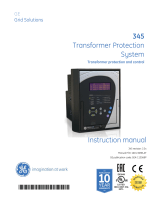
Table 2. Supported functions, continued
Function IEC 61850 A B C D
Pulse timer (8 pcs) PTGAPC 2 2 2 2
Time delay off (8 pcs) TOFGAPC 4 4 4 4
Time delay on (8 pcs) TONGAPC 4 4 4 4
Set-reset (8 pcs) SRGAPC 4 4 4 4
Move (8 pcs) MVGAPC 2 2 2 2
Generic control point (16 pcs) SPCGAPC 2 2 2 2
Analog value scaling (4 pcs) SCA4GAPC 4 4 4 4
Integer value move (4 pcs) MVI4GAPC 1 1 1 1
1, 2, ... = Number of included instances. The instances of a protection function represent the number of identical protection function blocks available in the standard
configuration.
() = optional
1) "Uo calculated" is always used.
2) Master trip is included and connected to the corresponding HSO in the configuration only when the BIO0007 module is used. If additionally the ARC option is selected, ARCSARC is
connected in the configuration to the corresponding master trip input.
3) Available only with IEC 61850-9-2
4) Available only with COM0031-0037
3. Protection functions
The relay offers all the functionality needed to manage motor
start-ups and normal operation, also including protection and
fault clearance in abnormal situations. The main features of the
relay include thermal overload protection, motor start-up
supervision, locked rotor protection and protection against too
frequent motor start-ups. The relay also incorporates non-
directional earth-fault protection, negative phase-sequence
current unbalance protection and backup overcurrent
protection. Furthermore, the relay offers motor running stall
protection, loss-of-load supervision and phase reversal
protection.
Standard configurations B, C and D additionally offer directional
earth-fault protection, three-phase undervoltage protection,
negative-sequence overvoltage and positive-sequence
undervoltage protection. Further, the B, C and D configurations
offer frequency protection including overfrequency,
underfrequency and rate-of-change frequency protection
modes.
The RTD/mA module offered as an option for standard
configurations A and B enables the use of the optional
multipurpose protection function for tripping and alarm
purposes using RTD/mA measuring data or analog values via
GOOSE messages.
In certain motor drives of special importance there must be a
possibility to override the motor thermal overload protection to
perform an emergency start of a hot motor. To enable an
emergency hot start, REM615 offers a forced start execution
feature.
Enhanced with optional hardware and software, the relay also
features three light detection channels for arc fault protection of
the circuit breaker, busbar and cable compartment of metal-
enclosed indoor switchgear.
The arc-fault protection sensor interface is available on the
optional communication module. Fast tripping increases staff
safety and security and limits material damage in an arc fault
situation. A binary input and output module can be selected as
an option - having three high speed binary outputs (HSO) it
further decreases the total operate time with typically 4...6 ms
compared to the normal power outputs.
4. Application
REM615 constitutes main protection for asynchronous motors
and the associated drives. Typically, the motor relay is used
with circuit breaker or contactor controlled HV motors, and
contactor controlled medium sized and large LV motors in a
variety of drives, such as pumps and conveyors, crushers and
choppers, mixers and agitators, fans and aerators.
The motor relay is thoroughly adapted for earth-fault protection.
Using cable current transformers sensitive and reliable earth-
fault protection can be achieved. Phase current transformers in
Holmgreen (summation) connection can also be used for earth-
fault protection. In that case possible unwanted operations of
the earth-fault protection at motor start-up due to CT saturation
can be prevented using the relay's internal interlocking features
or a suitable stabilizing resistor in the common neutral return.
The optional RTD/mA module offered for standard
configurations A and B facilitates the measurement of up to
eight analog signals via the six RTD inputs or the two mA inputs
using transducers. The RTD and mA inputs can be used for
temperature monitoring of motor bearings and stator windings,
thus expanding the functionality of the thermal overload
protection and preventing premature aging of the motor.
Furthermore, the RTD/mA inputs can be used for measuring the
ambient cooling air temperature. The analog temperature
values can, if required, be sent to other devices using analog
horizontal GOOSE messaging. Temperature values can also be
Motor Protection and Control
1MRS756890 N
Product version: 5.0 FP1
ABB 9




















